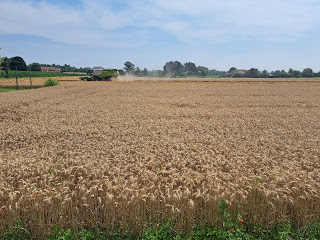Such pilgrims are rare in these days. They were stared at by everybody and treated with scant respect, for, in earlier times, many rascals roamed the countryside in this disguise. When I heard that they were Germans and could not speak any other language, I went aft to talk to them… Their main goal had been the Shrine of the Three Magi in Cologne; then they had wandered across Germany and were now on their way to Rome. After that they planned to return to northern Italy; then one would wander back home, while the other made a further pilgrimage to Santiago de Compostela.
Their habit was the conventional one… the wide cape, the round hat, the scallop shell, that most primitive of drinking vessels, everything had its meaning and immediate use. Their passports were in a tin box. The most curious of their belongings were the small portfolios of red Morocco in which they carried the small articles they needed for daily necessities. They had taken them out because they had found something in their clothes that needed mending.
- Goethe, Italian Journey (Written while sailing down the Brenta by boat, on 28 September 1786)
I walked two and a half kilometres along the back streets of Carmignano to get back onto the Via Romea Germanica walking route along the Brenta river, rejoining it by the gravel pit at Agugiaro. I then followed the Brenta walking/cycling route all the way to Piazzola, mostly on a shady path through the trees, though with occasional excursions into the open sunshine of the wheat and corn fields.
Following a cycling route like this one is easy, it's pretty much impossible to take a wrong turn or get lost, and there are only two concerns: 1. stay in the shade, and 2. walk on soft surfaces wherever possible. This means preferring the grassy edge over the gravel or asphalt cycling lane. Other than that, there's not much to worry about, except avoiding being hit by a bicycle; never cross a cycling path without looking over your shoulder first!
 |
| The back streets of Carmignano |
 |
| The gravel pit |
 |
| Cornfield |
 |
| Polenta in the making |
 |
| Harvest time already! |
After 18 kilometres of this easy but fairly monotonous walking I arrived in Piazzola sul Brenta: an unusual town, in that the town centre revolves entirely around Villa Contarini, the buildings constructed to serve it and the industries set up by its former owner in the late nineteenth century.
Piazzola sul Brenta and Villa Contarini
In 1413 Maria da Carrara, who had inherited all her family's possessions in Piazzola, married Venetian nobleman Nicolò Contarini, establishing the Contarini family's dominion over the area. In 1546 the Contarini family commissioned the building of a great villa, possibly designed by Andrea Palladio in its original core, much expanded and reworked over the centuries that followed.
The central core of the building resembles the Gothic villas facing onto the canals of Venice, looking oddly out of place here in the grassy plains! In the late seventeenth century Marco Contarini added the two large loggia wings on either side of the main building. In front of the villa is a vast piazza, now used for concerts and events, with a semi-circular loggia on one side, now containing shops and cafés; the planned matching loggia on the other side was never built. The villa hosted grandiose Baroque entertainments and theatrical performances, even including re-enactments of naval battles in the fishponds of its vast park.
 |
| One of the loggias |
 |
| The ballroom |



















No comments:
Post a Comment